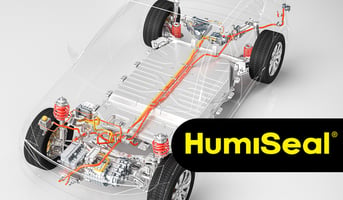Modern hydrogen fuel cell technologies require ever more sophisticated and reliable electronic...
Aromatic-Free Conformal Coatings: What Are My Options?

Xylene and Toluene. Two words that can evoke concern and add to paperwork for environmental health and safety departments and manufacturing professionals. Aromatic solvents have been safely used for decades by employing basic safety equipment including gloves, masks, and proper workplace ventilation. Nevertheless, concerns for maximizing employee safety and minimizing effects on the environment have led electronics manufacturers to seek out alternatives. For over 20 years, HumiSeal® has supplied a wide-ranging group of aromatic-free products across all traditional chemistries to manufacturers for whom these concerns are critical.
What aromatic free means?
First, a basic explanation of the structure and role of aromatic solvents is in order. The term “aromatic” in this context refers to cyclic hydrocarbons such as toluene, benzene, and xylene where the carbon atom structure is in the form of a closed ring, as opposed to “aliphatic” hydrocarbons such as hexane, where the carbon atoms are in a linear structure. The word aromatic is also used to describe the relatively strong, and not always pleasant, odor associated with compounds of this family.

 It is important to understand that in electronics coatings, these solvents, whether aromatic or aliphatic, are not functional parts of the finished coatings but are used only to dissolve and thin the products to allow them to be effectively sprayed or dipped. Since these solvents rarely have an effect on the final product’s performance but are simply evaporated away, it makes sense to choose the least hazardous version available that is adequate for the application method.
It is important to understand that in electronics coatings, these solvents, whether aromatic or aliphatic, are not functional parts of the finished coatings but are used only to dissolve and thin the products to allow them to be effectively sprayed or dipped. Since these solvents rarely have an effect on the final product’s performance but are simply evaporated away, it makes sense to choose the least hazardous version available that is adequate for the application method.
What are the problems with aromatic solvents?
There are many and they vary in importance but can be broken down into two main categories:
- health hazards including acute toxicity in large quantities, skin and eye irritation hazards, and acute and chronic risks to organs, such as neurotoxicity, due to inhalation of vapors
- environmental hazards, including toxicity to fish and wildlife as well as contributing to ozone and smog production
HumiSeal® has over two decades of experience in the design and manufacture of aromatic-free conformal coatings, using technologies such as:
- non-aromatic, environmentally friendlier solvents (LOS, NS, LOC suffixes)
- silicone-based chemistries that are 100% solids -- no solvents
- UV-curable-based chemistries that are 100% solids -- no solvents
| Acrylics | 1B31EPA, 1B31LOC, 1B73, 1B73LOC, 1B73LSE |
| Urethanes | 1A33LOS |
| Synthetic Rubbers | 1B51NS, 1B51NSLU, 1B58LU, 1B59LU |
| Silicones | 1C49, 1C49LV, 1C51 |
| UV Curables | UV40, UV40Solar, UV40Gel, UV92, UV500, UV50LV |
Although it is relatively simple to take precautions in the use of aromatic solvents, some users may prefer safer alternatives for their employees and the environment. This is not a new issue, and HumiSeal remains committed to the development and maintenance of products across all modern chemistries to provide choice and superior product performance in aromatic and toluene-free conformal coatings for the electronics industry.
As a supplier of all major forms and chemistries of conformal coatings, Chase Corporation and HumiSeal® can help you with an unbiased approach to evaluating your application and process. We’ll show you how to maximize efficiency, minimize cost, and improve product reliability. Our outstanding manufacturing and technical support groups can provide your organization with reliable global supply, unmatched quality, and superior technical support.
Please contact us today for a customized solution to your electronics coatings needs.




